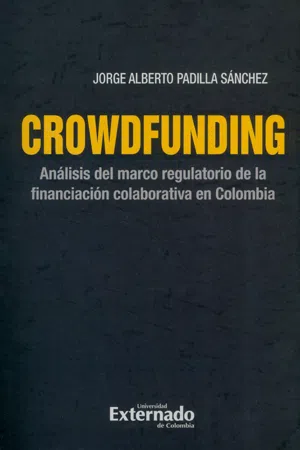
Crowdfunding : análisis del marco regulatorio de la financiación colaborativa en Colombia
- 318 páginas
- Spanish
- ePUB (apto para móviles)
- Disponible en iOS y Android
Crowdfunding : análisis del marco regulatorio de la financiación colaborativa en Colombia
Información del libro
El Crowdfunding es un nuevo instrumento para recaudar fondos que, de la mano con la evolución de la tecnología y como parte de la corriente FinTech, permite la prestación de servicios financieros de manera más eficiente y menos costosa, sirve como mecanismo de inclusión financiera. Hoy se encuentra en la mira de los reguladores alrededor del mundo, principalmente debido a su distanciamiento de los mecanismos tradicionales y las problemáticas asociadas a su desarrollo. El trabajo realiza un análisis detallado del fenómeno y la manera como los aportantes, receptores y plataformas electrónicas fueron regulados en Colombia por el Decreto 1357 de 2018. El lector encontrará un estudio crítico del valor del Crowdfunding Act de Estados Unidos como un modelo para la regulación en Colombia.
Preguntas frecuentes
Información
NOTAS AL PIE
INTRODUCCIÓN
Índice
- CUBIERTA
- PORTADILLA
- PORTADA
- CRÉDITOS
- CONTENIDO
- INTRODUCCIÓN
- CAPÍTULO PRIMERO CROWDFUNDING: LA REVOLUCIÓN DE LAS MASAS EN EL ACCESO A LA FINANCIACIÓN
- CAPÍTULO SEGUNDO EXPERIENCIA INTERNACIONAL EN LA REGULACIÓN DEL CROWDFUNDING: ESPECIAL MENCIÓN AL MODELO NORTEAMERICANO
- CAPÍTULO TERCERO LA REGULACIÓN DEL CROWDFUNDING EN COLOMBIA
- CONCLUSIONES
- REFERENCIAS
- NOTAS AL PIE
- CONTRACUBIERTA